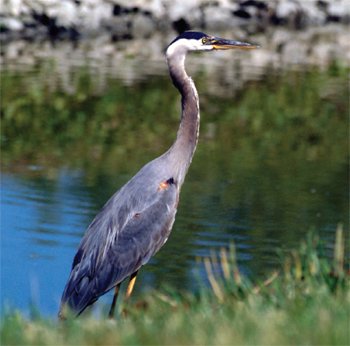Great Blue Heron
Standing as an elegant sculpture, the great blue heron remains motionless in the shallow water.

Standing as an elegant sculpture, the great blue heron remains motionless in the shallow water. When a fish comes within striking distance, the great blue heron will either spear or grab its meal and swallow it whole. Some herons have tried to swallow fish so large that the bird choked to death. These large birds can be seen fishing in lakes, rivers, marshes, streams, backyard pools, bays, ocean shores, tidal flats, and sandbars.
The great blue heron ranges from southeast Alaska and southern Canada as far as southern Mexico, the Galapagos Islands, and the West Indies. In Florida, there is a white color phase of the great blue heron.
Its long black legs allow it to wade in the water. The heron has the patience of Job as it waits on its prey. Three-fourths of the heron’s diet is fish but it will also take snakes, salamanders, frogs, insects, ground squirrels, young muskrats, shrimp, crayfish, and crabs. The long, sharp, pointed yellow beak is a weapon and a wounded bird can be dangerous. One struck a pine oar with such force that the beak protruded two inches (5.2 cm) on the other side.
When the great blue heron flies it has a slow wing beat, and travels at about 30 mph (48 km/h). Unlike geese and cranes, the heron doesn’t stick its neck out when flying, but carries its head against its body, hiding its long neck while its legs stick out behind. The wing span can be up to 7 feet (2.1 m) but most average 5 to 6 feet (1.5 to 1.8 m). When standing, they can be 4 feet tall (1.2 m).
The great blue heron is entirely gray-blue in color except for some white around the head and part of the neck. Some may have cinnamon-colored necks and legs, although the legs are normally black. It has a black stripe above the eye, which is yellow, the same as the bill.
The bird is usually silent; however, when startled, the heron makes a croaking sound, and while in flight, it honks.
The nest of the blue heron is usually 20 to 100 feet (6.1 to 30.5 m) above the ground on rocks and cliffs and is made up of small sticks. There may be only a few or up to hundreds of nests built in one area used by a group of herons. Both sexes incubate the three to seven blue-green eggs. The eggs hatch in 25 to 29 days and the chicks leave the nest in 62 to 90 days.
Great Blue Heron
Cicoriiformes • Ardeidae • Ardea herodias
Height: 4 feet (1.22 m)
Length: 42–52 inches (107–132 cm)
Life Span: 11 to 21 years
Special Design Feature: The sharp, long, pointed bill of the heron can
either grab or spear its prey.
Did you know? One wounded heron struck a pine oar with such force that
its beak protruded two inches (5.2 cm) on the other side.
Marvels of Creation: Breathtaking Birds
This spectacular book brings the world of feathered creatures alive in a unique and colorful way.
Browse Kids Book- © 2024 Answers in Genesis
- Privacy Policy
- Contact
- About

